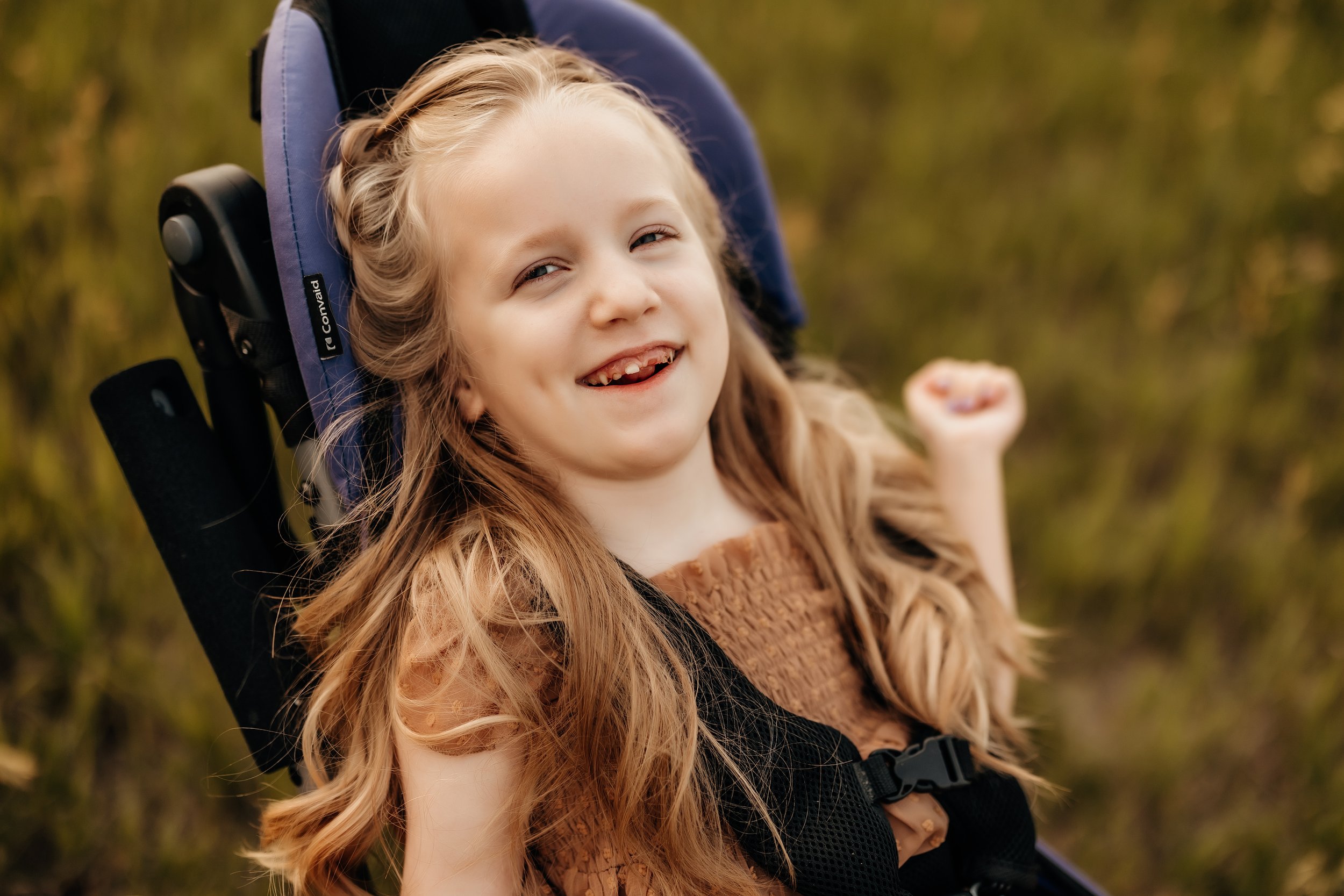
About Brynn
Brynn was born with Hypomyelinating Leukodystrophy
Brynn’s Story
Brynn has a form of hypomyelinating leukodystrophy caused by two gene mutations on her DEGS1 gene. This is an extremely rare occurrence, Brynn being one of the first twenty cases discovered. There are now over a hundred cases currently known. She received one mutation from each parent, who were unaware of these mutations prior to receiving her diagnosis. This disorder affects her body's ability to metabolize fatty acids and turn them into myelin or white matter in the brain and nervous systems. This leaves her physically disabled - she doesn't sit, stand, talk, walk, or even eat like other children her age. Brynn is now 7.
From birth to 8 months old, Brynn was developmentally normal - even ahead of some milestones. Around 9 months old, her mom noticed she was falling behind in motor skills and even regressing in some she'd already learned. Her pediatrician sent her for a developmental evaluation, and over the next year she lost the ability to take in enough nutrition and received an NG feeding tube & later received a g-tube to receive medications and nutrition.
Brynn and her parents did genetic testing in the fall of 2018 when she was 18 months old, and received the results the next January. Brynn's disorder is currently incurable, and she is treated symptomatically with several medications and procedures to keep her happy and healthy. Her disorder causes high muscle tone in her limbs, causing her hips to come out of place several times. She's had multiple hip surgeries to correct this, including a major surgery in July 2021 where they replaced the hips and placed metal clips in to keep them in their sockets. In February 2023 she had surgery to replace the hardware in her hips. Brynn has been through so much in her 7 years - many sedated procedures like MRIs, endoscopes, and injections. She's been hospitalized many times and handles it like a true champ. She currently has an additional issue with elevated liver enzymes of unknown cause, but her doctors are working on figuring out what is going on. For right now, her liver issues are a mystery.
Despite her brain actively losing white matter, Brynn is progressing in all areas. She is a happy, social girl who loves princesses and sparkles like other children her age. She loves school, dance class, participating in pageants, and her friends. Brynn shows everyone how smart she is by learning new things daily & has her own way of communicating with her family and friends. Brynn needs a lot of medical attention, equipment, and therapies to help her live her happiest and best life.
From Brynn’s Geneticist
“Brynn is a special girl who was born with a rare genetic condition called hypomyelinating leukodystrophy. This condition is caused by having two damaging genetic variants in the DEGS1 gene, one inherited from the mother and one inherited from the father, which cause loss or damage to the protein produced by the DEGS1 gene. The DEGS1 gene makes the instructions for a protein called delta 4-desaturase, sphingolipid 1, which is an important protein to generate and use sphingolipids in the body. Sphingolipids have many important functions in the body; and they are an important component of the myelin sheath surrounding the cells (neurons) in the brain and the peripheral nerves. Myelin acts as insulation around neurons to support signal transmission from one neuron to the next. When sphingolipids do not function properly, it causes underdevelopment and damage to the myelin sheath (hypomyelination), causing a neurological condition. The symptoms of this condition include severe developmental delay, abnormal muscle tone and weakness, seizures, feeding difficulties, and slow weight gain. The diagnosis is made through genetic testing and hypomyelination on brain imaging.
This condition was first published in the medical literature in 2019. At this time, there are approximately less than 50 individuals in the medical literature described with this condition. As a newly described genetic condition we are still learning about the variability and progression of symptoms in different individuals. Sadly, at this time there is no effective cure for this condition. Researchers are working to better understand how the disease works to develop treatments to help fight this condition. Thank you for considering supporting the important work to develop treatments and a cure for this condition.”
-Dr. Kristen Wigby, M.D.
Clinical Genetics, Rady Children’s Hospital Department of Genetics and Dysmorphology












